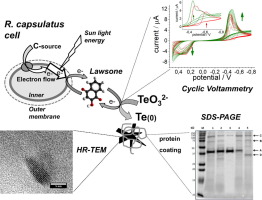当前位置:
X-MOL 学术
›
Bioelectrochemistry
›
论文详情
Our official English website, www.x-mol.net, welcomes your feedback! (Note: you will need to create a separate account there.)
Structural and electrochemical characterization of lawsone-dependent production of tellurium-metal nanoprecipitates by photosynthetic cells of Rhodobacter capsulatus.
Bioelectrochemistry ( IF 5 ) Pub Date : 2020-01-08 , DOI: 10.1016/j.bioelechem.2020.107456 Roberto Borghese 1 , Marco Malferrari 2 , Marco Brucale 3 , Luca Ortolani 4 , Martina Franchini 1 , Stefania Rapino 2 , Francesca Borsetti 5 , Davide Zannoni 1
Bioelectrochemistry ( IF 5 ) Pub Date : 2020-01-08 , DOI: 10.1016/j.bioelechem.2020.107456 Roberto Borghese 1 , Marco Malferrari 2 , Marco Brucale 3 , Luca Ortolani 4 , Martina Franchini 1 , Stefania Rapino 2 , Francesca Borsetti 5 , Davide Zannoni 1
Affiliation

|
Cells of the facultative photosynthetic bacterium Rhodobacter capsulatus exploit the simultaneous presence in the cultural medium of the toxic oxyanion tellurite (TeO32-) and the redox mediator lawsone (2-hydroxy-1,4-naphthoquinone) by reducing tellurite to metal Te0 nanoprecipitates (TeNPs) outside the cells. Here we have studied the mechanism by which lawsone interacts with metabolically active cells and analysed both structure and composition of the TeNPs collected from the growth medium of phototrophycally grown R. capsulatus. High Resolution Transmission Electron Microscopy (HR-TEM) images and Energy-Dispersive X-ray (EDX) microanalysis of TeNPs showed a central core of polycrystalline tellurium interspersed in an organic matrix with a predominant protein-based composition. The main proteins from Te0 nanostructures were identified by Liquid Chromatography tandem-Mass Spectrometry and were all correlated with the cell outer membrane composition. The interaction of reduced lawsone with tellurite and with the bacterial cells was probed by Cyclic Voltammetry and Scanning ElectroChemical Microscopy (SECM). We concluded that lawsone is required for the reduction of tellurite to metal Te0 in a reaction mechanism dependent on reducing equivalents deriving from the cell photosynthetic metabolism. SECM experiments demonstrate that lawsone, by diffusing inside the bacterial cells, is effectively available at the membrane site of the photosynthetic electron transport chain.
中文翻译:

荚膜红细菌光合作用细胞对Lawson依赖的碲金属纳米沉淀产物的结构和电化学表征。
兼性光合细菌荚膜红细菌的细胞通过将亚碲酸盐还原为金属Te0纳米沉淀物(TeNPs),利用培养基中同时存在有毒的氧阴离子亚碲酸盐(TeO32-)和氧化还原介体Lawone(2-羟基-1,4-萘醌)。 )。在这里,我们研究了律师与代谢活性细胞相互作用的机制,并分析了从光营养生长的荚膜红球菌生长培养基中收集的TeNPs的结构和组成。TeNP的高分辨率透射电子显微镜(HR-TEM)图像和能量分散X射线(EDX)显微分析显示,多晶碲的中心核散布在有机基质中,该基质具有主要的蛋白质基成分。Te0纳米结构的主要蛋白质通过液相色谱串联质谱法鉴定,并且都与细胞外膜组成相关。通过循环伏安法和扫描电化学显微镜(SECM)探测还原的草酮与亚碲酸盐以及与细菌细胞的相互作用。我们得出的结论是,在依赖于减少源自细胞光合作用代谢的当量的反应机制中,必须将Lawone还原为亚碲酸盐成金属Te0。SECM实验表明,通过在细菌细胞内部扩散,可在光合作用电子传输链的膜位点有效地获得Lawone。通过循环伏安法和扫描电化学显微镜(SECM)探测还原的草酮与亚碲酸盐以及与细菌细胞的相互作用。我们得出的结论是,在依赖于减少源自细胞光合作用代谢的当量的反应机制中,必须将Lawone还原为亚碲酸盐成金属Te0。SECM实验表明,通过在细菌细胞内部扩散,可在光合作用电子传输链的膜位点有效地获得Lawone。通过循环伏安法和扫描电化学显微镜(SECM)探测还原的草酮与亚碲酸盐以及与细菌细胞的相互作用。我们得出的结论是,在依赖于减少源自细胞光合作用代谢的当量的反应机制中,必须将Lawone还原为亚碲酸盐成金属Te0。SECM实验表明,通过在细菌细胞内部扩散,可在光合作用电子传输链的膜位点有效地获得Lawone。
更新日期:2020-01-09
中文翻译:

荚膜红细菌光合作用细胞对Lawson依赖的碲金属纳米沉淀产物的结构和电化学表征。
兼性光合细菌荚膜红细菌的细胞通过将亚碲酸盐还原为金属Te0纳米沉淀物(TeNPs),利用培养基中同时存在有毒的氧阴离子亚碲酸盐(TeO32-)和氧化还原介体Lawone(2-羟基-1,4-萘醌)。 )。在这里,我们研究了律师与代谢活性细胞相互作用的机制,并分析了从光营养生长的荚膜红球菌生长培养基中收集的TeNPs的结构和组成。TeNP的高分辨率透射电子显微镜(HR-TEM)图像和能量分散X射线(EDX)显微分析显示,多晶碲的中心核散布在有机基质中,该基质具有主要的蛋白质基成分。Te0纳米结构的主要蛋白质通过液相色谱串联质谱法鉴定,并且都与细胞外膜组成相关。通过循环伏安法和扫描电化学显微镜(SECM)探测还原的草酮与亚碲酸盐以及与细菌细胞的相互作用。我们得出的结论是,在依赖于减少源自细胞光合作用代谢的当量的反应机制中,必须将Lawone还原为亚碲酸盐成金属Te0。SECM实验表明,通过在细菌细胞内部扩散,可在光合作用电子传输链的膜位点有效地获得Lawone。通过循环伏安法和扫描电化学显微镜(SECM)探测还原的草酮与亚碲酸盐以及与细菌细胞的相互作用。我们得出的结论是,在依赖于减少源自细胞光合作用代谢的当量的反应机制中,必须将Lawone还原为亚碲酸盐成金属Te0。SECM实验表明,通过在细菌细胞内部扩散,可在光合作用电子传输链的膜位点有效地获得Lawone。通过循环伏安法和扫描电化学显微镜(SECM)探测还原的草酮与亚碲酸盐以及与细菌细胞的相互作用。我们得出的结论是,在依赖于减少源自细胞光合作用代谢的当量的反应机制中,必须将Lawone还原为亚碲酸盐成金属Te0。SECM实验表明,通过在细菌细胞内部扩散,可在光合作用电子传输链的膜位点有效地获得Lawone。


























 京公网安备 11010802027423号
京公网安备 11010802027423号